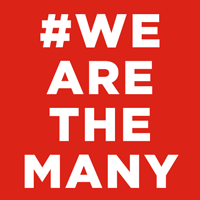
Welcome to the 2015 State of Hate Report, our annual review of hate politics in the UK and across Europe.
This year’s report has been compiled against a backdrop of increasingly depressing political circumstances. The refugee crisis – the largest movement of people ever across Europe – and the terrorist attacks in Paris, have contributed to an atmosphere of mounting antipathy to immigrants and a growing fear and suspicion of Muslims.
Attitudes are hardening and, in response, virtually every government across Europe is pulling up the drawbridges and trying to discourage refugees and migrants from crossing its borders.
Against this bleak political backdrop, people might be surprised to learn that Britain’s far right continues to be isolated and in retreat. Splintered and fractured, it is leaderless and rudderless. However, because of all this, it is becoming more extreme and violent, a trend we believe will continue over the coming year.
This 68-page report charts the fortunes of Britain’s far right groups, assessing individual organisations and profiling the movement’s leaders but also estimating the trends shaping the movement and its future direction.
It explores the state of hate across Europe, both investigating the rising anti-immigrant rhetoric and policies by EU Governments but also profiling the main far right organisations in each country.
And, in a new development from previous reports, we also examine Islamist extremism, many of these groups and individuals push as divisive and hateful an agenda as any far right group. HOPE not hate believes that we need to be consistent in our approach and challenge extremism and hate in whatever guise they manifest themselves.
Smaller but more violent: The far right in 2015
The political and economic conditions could not be better for Britain’s far right. Why, then, is it doing so badly?
HOPE not hate explores the fortunes of Britain’s far right in 2015.
2015 was a year of violence and humiliations for the British far right, the general election proving its political impotency, the EDL continuing its steady decline into oblivion and, while the number of far right demonstrations increased, especially in the north of England, the overall numbers involved in the far right declining.
The year was best summed up by the spectacle, in August, of National Action (NA) activists scrambling to pull down the shutters of Liverpool Lime Street’s s left luggage office in a bid to save themselves from pursuing anti-fascists.
On the surface, it really should not be like this. Difficult economic conditions and austerity policies, compounded by the refugee crisis which has resulted in the biggest ever movement of refugees into Europe, have produced a toxic mix that the far right should have exploited and prospered from.
Similarly, the terrorist attacks in Paris, coupled with feared attacks in Belgium and Germany, have fed the worries of homegrown Jihadism and even of the incompatibility of Islam with Western Civilisation.
Despite all this, 2015 was not a good year for Britain’s far right.
The key political event of 2015 was May’s General Election but whereas the BNP contested it properly in 2010, saving its deposit in 73 constituencies, this time its results hardly registered. The party stood a mere 8 candidates, compared with 338 in 2010, averaging just 0.44% of the vote. Nowhere did the party score even 1% of the vote in what turned out to be its worst result since 1987.
A significant reason for the far right’s disastrous showing was UKIP which stole the media limelight and most of the BNP’s voters. While it won one parliamentary seat, over four million people voted for the party and gained 14% of the national vote.
It would be wrong to attribute the far right’s failure entirely to UKIP as internal infighting, poor leadership and an identity crisis over the very future of racial nationalism have greatly affected the movement’s fortunes.
Knock-on effect
The ramifications of the BNP’s decline continue to have significant effect on the far right scene. It is almost hard to imagine now but, in 2010, it seemed that it stood a very real chance of breaking out of the marginalised political ghetto and into the mainstream like no other far right party in the post-war period. Yet, it was not to be and the years that followed have been increasingly schismatic, resulting in the rapid and dramatic decline of the party into a state of near irrelevance.
At its height the BNP was a dominant and almost monolithic force within the movement but its decline has resulted in a more diffuse scene made up of numerous small and often irrelevant groupuscules scrabbling for influence and members.
2015 saw the further splintering of the BNP with numerous new breakaway groups, most notably towards the end of the year when Jack Sen left to form British Renaissance, taking with him sections of the party’s North West and London branches.
To find a comparable period when the British far right lacked any predominant party and was splintered to this extent one has to go back to before the National Front’s formation in 1967.
This has not gone unnoticed within the movement itself and talk of the need for new alliances is getting louder. However, the often-bitter disputes and splits that have so devastated the BNP are still relatively recent making any attempts at greater cooperation in 2016 difficult.
These problems are exacerbated by the absence of a credible and respected prospective leader, something that would be essential to bringing the nationalist movement back together and out of the wilderness.
Combined, these factors go some way to explaining why the British far right – unlike some other far right parties in Europe – has been so unsuccessful.
In addition to affecting the makeup of the far right, the BNP’s demise, coupled with the simultaneous rise of UKIP, has altered the nature of the scene as it has become more polarised.
The BNP’s earlier successes meant that it could hold together a broad church of activists ranging from the far right of the Tory party through to the fascists and nazis that make up the extreme far right of the political spectrum.
Table: BNP elections results 1983-2015
| Year | No. of candidates | Total votes | Avg. votes per candidate | % of vote | Saved deposits |
|---|---|---|---|---|---|
| 1983 | 53 | 14,621 | 276 | 0 | 0 |
| 1987 | 2 | 553 | 277 | 0 | 0 |
| 1992 | 13 | 7,631 | 587 | 0.1 | 0 |
| 1997 | 56 | 35,832 | 640 | 0.1 | 3 |
| 2001 | 33 | 47,129 | 1,428 | 0.2 | 7 |
| 2005 | 119 | 192,746 | 1,620 | 0.7 | 34 |
| 2010 | 338 | 563,743 | 1,668 | 1.9 | 73 |
| 2015 | 8 | 1,667 | 208 | 0 | 0 |
With the BNP’s demise, those former members from the extreme wing of the party, many of whom have formed and found homes in groups like the British Democratic Party, have dropped the moderate façade demanded of them by the BNP’s modernisation programme. While tolerated when the tactic seemed to be garnering electoral success, it has been increasingly jettisoned.
The result is that a number of the BNP splinter groups active last year were more markedly extreme than the BNP had been.
UKIP’s rise has accelerated this rightward shift in two ways. Firstly, a section of the BNP’s more moderate supporters made their way over to UKIP leaving the BNP and its splinter groups with just the more radical and extreme elements.
Then, with UKIP setting up camp on a portion of the electoral landscape previously occupied by the BNP, the far right sought to distinguish itself by shifting back towards its more traditional, and extreme, homeland, a move that deposed BNP chief Nick Griffin supported.
The decline of the BNP and the rise of UKIP have thus brought a halt to the UK far right’s modernisation programme and seen the jettisoning of the moderate stance.
In addition, large portions of the far right have become disillusioned with electoral politics all together. Even Griffin, formerly the leading advocate of the tactic, did a volte-face in 2015 declaring: “It is time for radical nationalists to learn from the success of the left that has come from their clear recognition that ‘There Is No Parliamentary Road to Socialism’”.
In some ways, the internal discussion regarding the validity of the electoral route to power is purely academic, a point explained in Heritage and Destiny, the leading UK-based racial nationalist newspaper: “While nationalists continue to debate the value of electoral campaigning, in practise the decision seems to have been resolved (at least for the time being) by the sheer inability of our various parties to organise candidates anywhere outside literally a handful of viable branches.”
More Splintered and More Extreme
2015 also saw the continuing decline in the English Defence League, which was now a mere shadow of its former self.
The group held twelve demonstrations throughout the year, down from twenty-five in 2014, with the largest being just 150-strong. Most demonstrations were considerably smaller.
This situation compares with the 3,000 who marched in Newcastle in 2013, admittedly just after the murder of Lee Rigby, but also the 2,500 who marched in Stoke-on-Trent in 2010 and the 2,000 in Dudley in the same year.
The EDL’s decline began some time before founder and former leader Stephen Lennon walked out but last year saw a demoralised and faction-riven leadership slip further into oblivion. National organiser Dave Bolton was ousted, not before debilitating faction fighting and resignations, and others jumped ship when it was clear that former leader Stephen Lennon was making a political comeback.
In reality, however, he had never lost contact with several EDL activists, including West Midlands-based Steve Eddows and the EDL’s “security team” who were merely treading water in the EDL until their former leader returned.

Self-radicalising: Several of the NWI leaders now openly align themselves to the nazi group Combat 18 and regularly display C18 flags, wear C18 balaclavas and C18 facemasks on demonstrations. The official NWI flag now carries the fire-breathing dragon, which is used by C18 leaders internationally across Europe, including C18 leader Will Browning, who uses it as his Facebook profile picture. Leader Shane Calvert has even posed outside Buckingham Palace with his C18 flag.
A far more worrying development in 2015 was the continuing growth and militancy of the Infidels, a network of regional fascist gangs pursuing a far more confrontational and violent agenda. Most prominent amongst the Infidels groups is the North West Infidels (NWI), led by Blackburn-based thug Shane Calvert.
With about 25 in its core and another 15-20 in a wider periphery, the NWI is one of the most active of these groups. During 2015, it organised or supported twelve demonstrations, twice the number of the previous year.
The NWI was involved in several serious clashes with left wing opponents, in addition to its general harassment and intimidation of trade unionists and anti-UKIP campaigners across the region.
Others in the Infidel network include the North East Infidels (North East), the Valley Front Line Firm (South Wales), the South East Alliance and a small gang in the Coventry area, led by Tommy Law. Nationally, they have a combined core of 150 violent and confrontational people. The NWI is closely aligned to the National Front, attending many of their events and sharing some activists.
The most violent confrontation of 2015 was NA’s “White Man March” in Liverpool, which ended in utter humiliation for the group as its supporters were forced to take shelter in Liverpool Lime Street station’s left luggage department.
The Liverpool debacle severely damaged the reputation of a group that had captured media headlines in 2014 and re-confirmed the view of the group by others on the far right, including NWI, that is was just a bunch of brash kids without much backbone.
NA appears to be the most organisationally sophisticated far right group on the scene currently, however,having its own internal internet forum and highly guarded public fora with many of its activists using fake personalities to engage online. It is also the only UK far right group to make active use of the Dark Web.
While this type of online behaviour and encrypted security is now quite common amongst environmental and anti-capitalist organisations, it is unique on the British far right.
Survivalism
The growing radicalisation and militancy of the far right, coupled with the humiliation and bruised faces from Liverpool has led to rising participation in survivalist and martial arts training.
Among the groups offering this training are Misanthropic Division and Legion, formerly known as Sigurd Legion. The former is led by Francesco Saverio Fontana, a former member of the fascist Azov Battalion in Ukraine and a member of the Italian nazi group, Casa Pound, and involves Jimmy Hay, a MMA trainer who runs a gym in Greater Manchester.
Legion is led by Craig Fraser and a video of one of its camps, held in Wales, shows two men stripped to the waist pummelling each other as they practice unarmed combat and others training with knives.
In his book Centurion Method, Fraser tells his followers: “Violence is the key to manhood, a man who cannot do violence, either to himself, his comrades or his enemies is a dead man...Practice violence then, harm yourself, experience pain, practice the traditions of the day, learn to hunt, to kill, to maim and to dominate in battle.”
NA, the NWI and unaligned activists are among the 80-100 people who went through these training camps during 2015.

National Action supporters take cover in the left luggage office at Liverpool Lime Street station. This defeat was a humiliation for the group.
Flops
It has not all been plain sailing for the more militant end of the far right, with some older activists and groups being on the slide. 2015 was a bad year for Eddie Stampton, a veteran nazi who has been through a plethora of groups in recent years. He became increasingly marginalised and isolated after falling out with virtually everyone.
Also on the decline is the Racial Volunteer Force, led by former Combat 18 activist Mark Atkinson. With Stampton, Atkinson was heavily involved in a bid to march through the heavily Jewish area of Golders Green, in north London, last summer. Forced to change their plans after widespread community opposition, just twenty-seven nazis ended up marching in central London instead.
The National Front also suffered serious splits within its ranks and towards the end of the year Kevin Bryan resigned as leader. Just a hundred people, compared with three hundred in 2014, attended the NF’s annual Remembrance Sunday demonstration. The NF’s new leader is Scottish and that alone is deemed unacceptable to many party members.
Britain First’s year was one of stagnation. Its huge social media footprint was not translated into any growth in offline activism and the group failed to mobilise more than two hundred people for any single event.
Party leader Paul Golding appeared more obsessed about selling merchandise but even this appeared to be on the wane as the year wore on.
One growth area during 2015 was the far right intellectual think tanks, especially the London Forum, led by former British Army Corps of Signals officer Jeremy ‘Jez’ Turner. The group has attracted leading national socialists, Holocaust deniers and conspiracy theorists from across the globe to its meetings. More significantly, the Forum, and in particular Turner and his side kick Larry Nunn, have become increasingly influential on the far right, especially with NA.
One foreign speaker who never made it to a British Renaissance luncheon was US Nazi Matthew Heimbach, who was barred from entering the UK by Home Secretary Theresa May in November 2015.
In last year’s State of Hate review we reflected on the loss of the movement’s three most prominent figures, former BNP leader Nick Griffin, EDL founder Stephen Lennon and Britain First’s Chairman Jim Dowson. All three tried to make a comeback in 2015.
Griffin and Dowson tried to rekindle a formerly successful working relationship, but this time solely for their own personal benefit. In connection with the Italian fascist Roberto Fiore, the pair began establishing contacts with Russian extremists in the hope of getting funding for their projects back home.
When that proved unsuccessful, Dowson took to hawking Griffin around dusty old churches in central and eastern Europe building relationships with Catholic anti-abortionists worried about the influx of non-Christian migrants.
Meanwhile, Lennon was released from prison for his mortgage fraud conviction and set about re-establishing himself in the Counter-Jihad world. As part of a bid, with Anne Marie Waters, to make her Sharia Watch UK a financial lucrative operation, Lennon sought out Dowson to join the business and run the online operation.
Of course, it all went horribly wrong. Lennon, Waters and Alan Ayling (aka Alan Lake) spilled the beans about their plan to hold a “Muhammad cartoon” event in the UK in order to provoke a violent reaction. Dowson, who genuinely believed the plot was so mad that it could have been a police entrapment, immediately went public to denounce them.
The resulting publicity, following the publication of a HOPE not hate report, forced Lennon to back away from rejoining the fray but this proved to be just temporary as within a couple of months he began building a relationship with the faltering Pegida movement in Germany.
Of the three, Lennon has best chance of making 2016 a success. Not only is he more of a household name and media savvy but Counter-Jihadism is, in the present circumstances, far more likely to have resonance than either the racial nationalism of Griffin or the conspiratorial anti-Islam and anti-Zionist rhetoric of the Christian evangelical Dawson.
However, it would appear that Lennon’s stock is not as high as he thinks. If he really believes that he can build a respectable middle-class movement, like Pegida, in the UK, he is badly mistaken. Not only is he badly damaged goods but the people who he has surrounded himself with in the Pegida leadership – Paul Weston and Anne Maria Waters – are both politically extreme and unlikely to attract any normal people.

Tommy Robinson in Utrecht bei Pegida Nederland 11.10.15.
Muslims and Transnational Cooperation
A major trend that was accelerated and cemented in 2015 was the shift of anti-Muslim politics to the top of the British far rights agenda. There are of course exceptions to this with a number of small groups who, while not wanting Muslims in the UK, see common cause with Muslims and the Palestinian cause because of their visceral, and often conspiratorial, antisemitism.
However, in the last decade or so a significant shift has occurred as anti-Muslim hatred has increasingly dominated the British far right’s ideology.
While attacking Muslims is nothing new, the 2015 migrant crisis and the Islamic State’s mass murder in Paris have confirmed it as the undisputed number one issue for most of the movement.
For some groups, such as the EDL and Britain First, Islamophobia forms the core of their ideology and dominates everything they do.
They form what we describe as the “Counter-Jihad” movement. There are other groups, though, who outwardly make anti-Muslim hatred central to their rhetoric while internally continuing to perceive the Jews as the real threat.
If anti-Muslim hatred is becoming ever more common on the far right so traditional racial nationalism – as espoused by groups like the BNP and the NF – is struggling to find traction. Not only is Counter-Jihadism now dominant but fewer Britons can remotely envisage a “white-only” society.
The Counter-Jihad ideology is more internationalist in its outlook. Unlike the traditional belief that the enemy, namely the Jews, is within, the far right increasingly views the threat as external, namely Islam and Muslims.
More activists and organisations, especially within the Counter-Jihad movement, perceive the threat to be the “Islamisation” of Europe or the West.
While lamenting the presence of Muslims and Islam within Britain, already there is a general feeling – deepened by the 2015 migrant crisis – that Muslims are invading and conquering Europe as a whole. This has led to increasing attempts to forge genuinely transnational coalitions such as the failed European Defence Leagues and now the “international” Pegida movement announced in late 2015.
This internationalisation was also evident beyond the Counter-Jihad movement with the New Right, a UK- based far right pseudo-think-tank, entertaining an unprecedented number of speakers from across Europe and North America.
Whether this trend will continue throughout 2016 is hard to say. In terms of the Counter-Jihad movement, primarily a cultural rather than racial nationalist ideology, international cooperation is a central aspect of its plan of resistance.
The Mainstreaming of Far Right Rhetoric
One of the most disturbing trends of 2015 was the seeming normalisation of far right rhetoric, especially in connection immigration and Muslims. With the rise of ISIS, terrorism in Paris and the migrant crisis, the traditional language and even polices of the far right became worryingly mainstream.
Rhetoric and behaviour that was once the preserve of the out-and-out extremists has now become increasingly mainstreamed.
Papers such as The Express, Sun and Daily Mail have published articles on the refugee crisis that would not have been out of place in the propaganda of the BNP or the NF. Notable low points included Katie Hopkins’ Sun article describing migrants as a “plague of feral humans” and claiming that “Some of our towns are festering sores, plagued by swarms of migrants and asylum seekers”.
Another low was the Daily Mail cartoon that portrayed migrants as rats swarming across the border in an image not just reminiscent of but very close to the Nazi antisemitic propaganda of the 1930s.
PM David Cameron, too, hit the depths describing migrants as “swarm”. While the far right is more marginalised and ignored than it has been in decades its ideas now have an all-too-evident resonance in the mainstream.

Convicted: Zack Davies and Joshua Bonehill-Paine
26-year-old Zack Davies were convicted for life for the attempted murder of Dr Sarandev Bhambra with an axe in a Tesco shop in north Wales. Davies claimed that the attack was revenge for the death of the soldier Lee Rigby, who was killed by Islamist extremists outside a barracks in south-east London. Davies had recently joined National Action, though he had a five-year history in engaging with far right groups online.
22-year-old Joshua Bonehill-Paine was convicted for three years for inciting racial hatred after he published antisemitic material online. He was described in court as “an extremist” who had expressed “virulently racist views in respect to the Jewish community”. Bonehill-Paine was well-known for harassing opponents online and had become increasingly extreme and aggressive in his online postings.
State of Hate 2015 in pictures


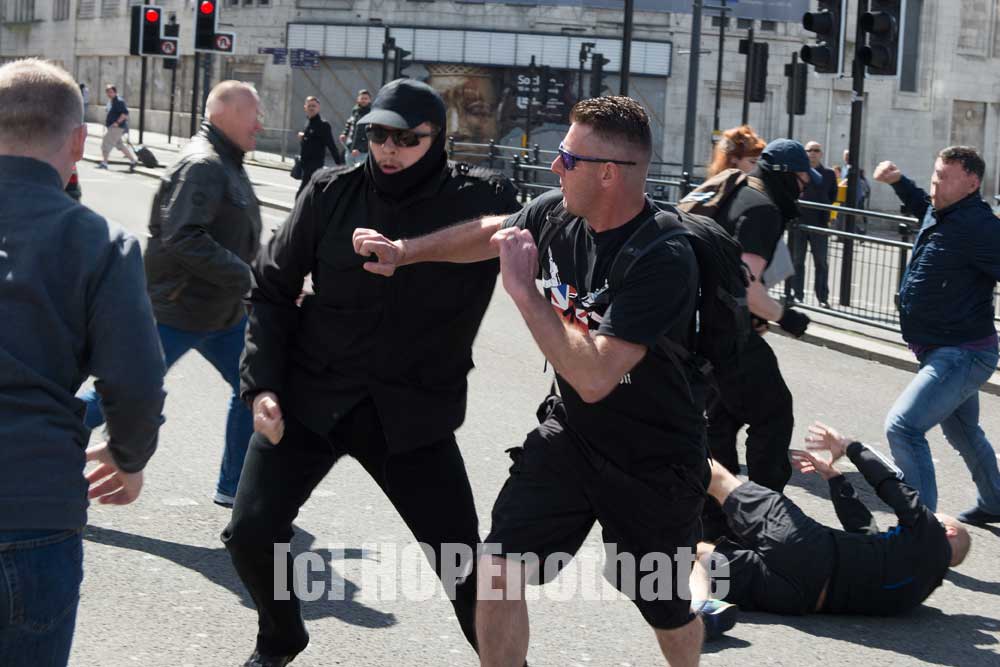

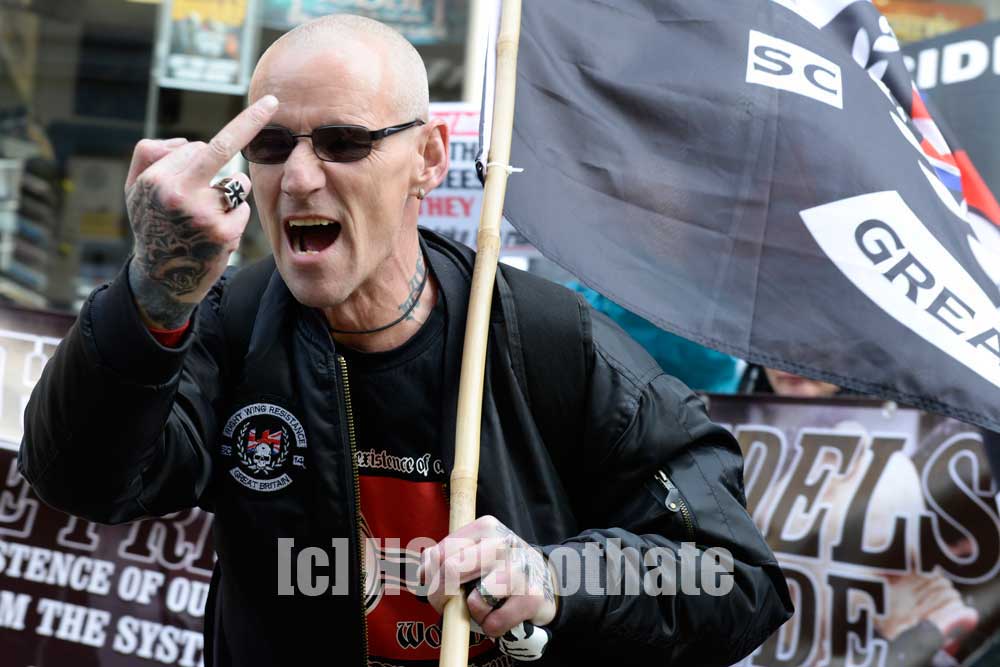

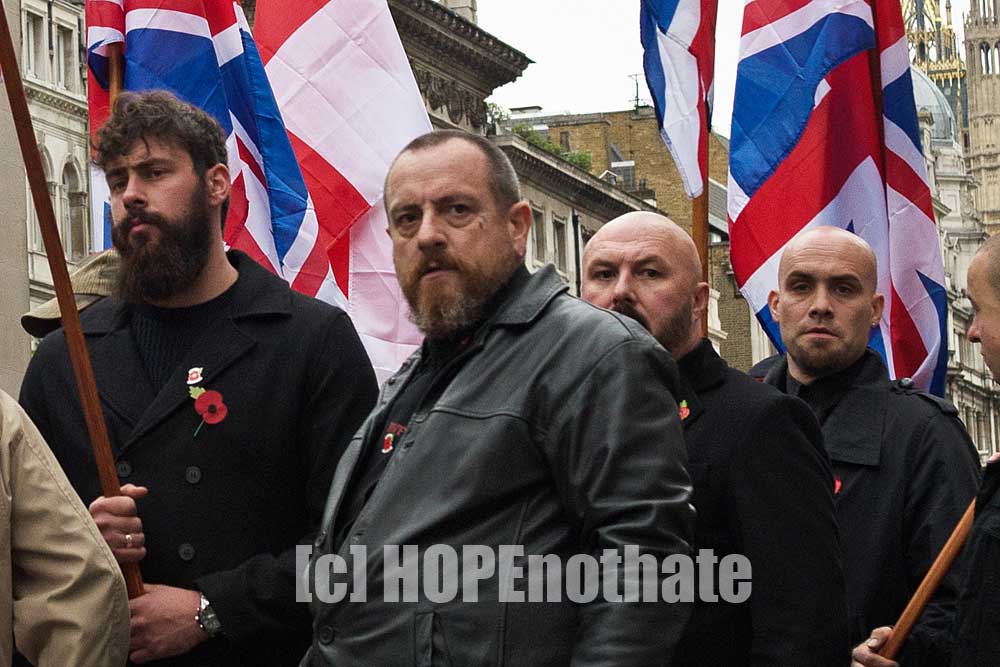


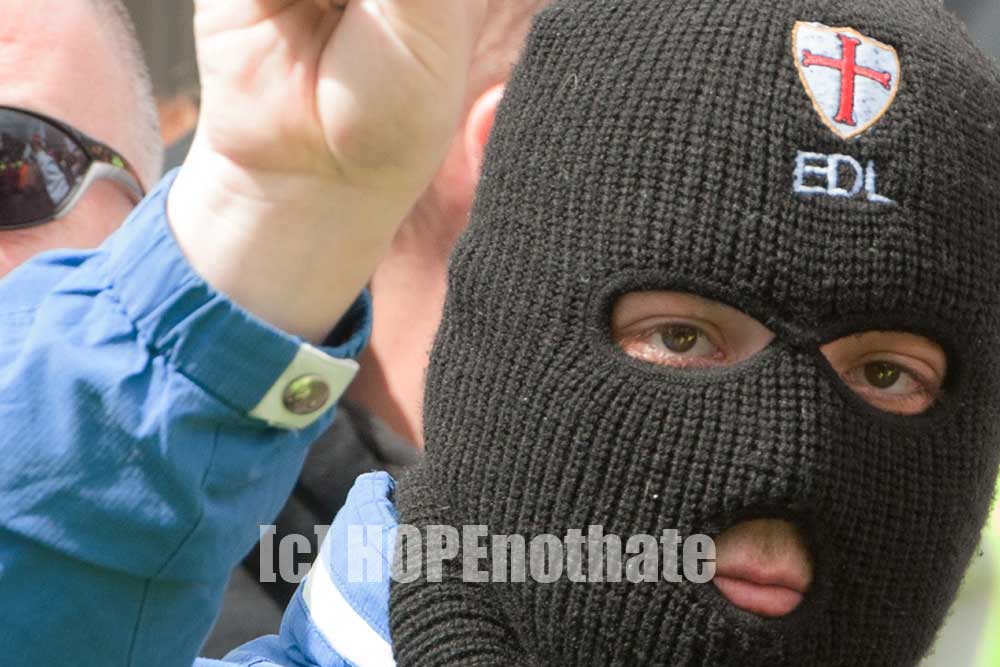
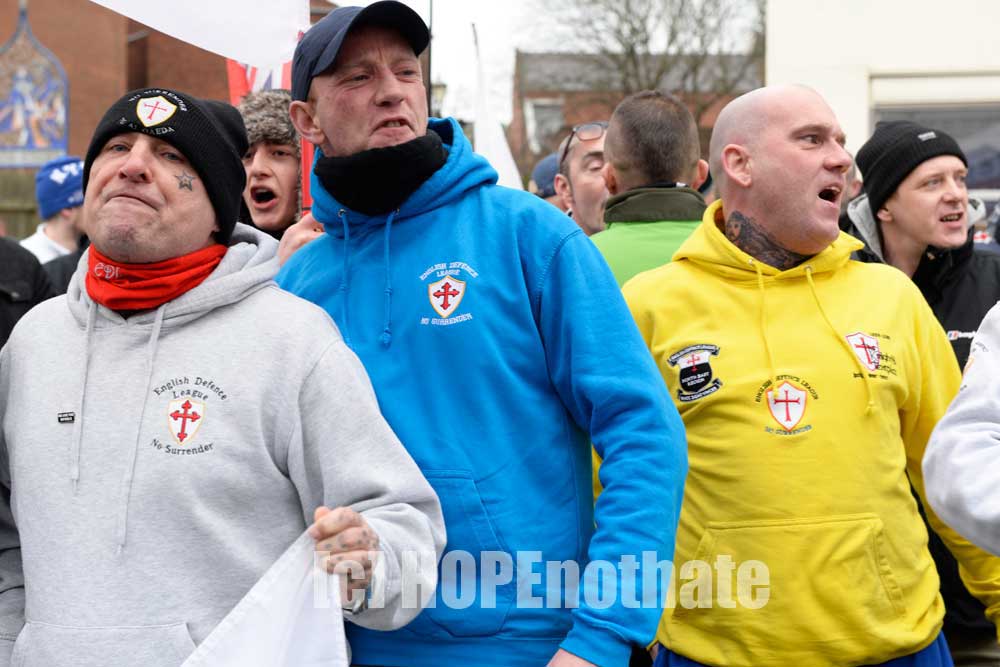


HOPE not hate magazine: January / February 2016 issue out now
State of Hate 2015 report
This 68-page report charts the fortunes of Britain’s far right groups, assessing individual organisations and profiling the movement’s leaders but also estimating the trends shaping the movement and its future direction.
It explores the state of hate across Europe, both investigating the rising anti-immigrant rhetoric and policies by EU Governments but also profiling the main far right organisations in each country.
Click here to subscribe to HOPE not hate magazine to see the full report

